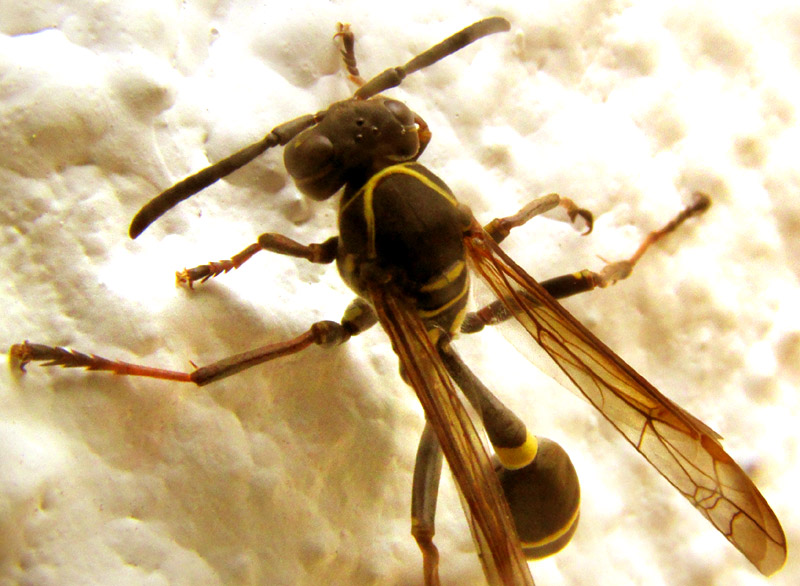Excerpts from Jim Conrad's
Naturalist Newsletter
Entry dated August 8, 2024, issued from near Tequisquiapan; elevation about 1,900m, (6200 ft), ~N20.57°, ~W99.89°; Querétaro state, MÉXICO
A WALL-PERCHING LONG-WAISTED PAPER WASP

At dawn the above small wasp was one of two who turned up on the house's eastern wall. They could have been drawn there by the potential warmth of sunrise, which hadn't yet quite occurred, or by the security light above them, which all night had betrayed night-navigating beings such as moths.

I've seen this species several times, but always it's been moving too fast for a good photo. This morning's wall-perchers were chilly, waiting for solar energy to energize their systems. Now it was clear that these waps had amazingly long, narrow waists, and elegant yellow markings.
The wasps were members of the very large, mainly tropical, strictly American genus Mischocyttarus. That awkward-feeling was name derived from the classical Greek μίσχος, for "stalk," and κύτταρος, for "honeycomb cell": "stalked honeycomb." Their "honeycombs" are paper combs like those often seen under house eaves, except that they're much smaller and with fewer cells. As with larger paper-wasp species, foraging adults bring flower nectar and small caterpillars back to the nest, to feed the developing wasp larvae, with one larva in each nest cell.
Over 200 Mischocyttarus species are known to exist, though only three species appear north of the Mexican border. One of those speccies Mischocyttarus mexicanus, the Mexican Long-waisted Wasp, at first glance is very similar to our wall-percher. However, the narrow, yellow lines atop our wasp's abdomens have a different arrangement from that species, and our species' compound eyes lack a yellow rim around them. These yellow markings are like stripes on a soldier's arm patch, letting us know with very modest signals of the soldier's appearance, which kind of soldier he is.
After decoding the yellow markings, it was clear we had MISCHOCYTTARUS PALLIDIPECTUS, a species occurring throughout most of Mexico, except the northwestern part, south into Costa Rica, and maybe into northwestern South America.
A feature of Mischocyttarus long-waisted wasps is that not all nests in the species produce females with developed ovaries. Thus different kinds of female wasps are produced, some destined just to work at foraging for food and for defending the nest, while others can mate, and go off to produce new nests. Studies slowly explain how environmental effects account for the ratio of fertile and infertile females a nest produces.